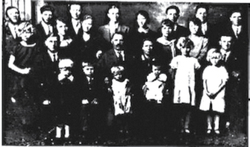Pipestone Flyer
Leduc has, over time, had many individuals that have made a major impact on the development of the city. However there are a number of individuals that made a contribution through the life they led and too often these individuals go unnoticed or are forgotten over time.
Gottlieb Wedman (Weideman) was such a person. Gottlieb was a German born on May 21st, 1871 in the Volhynia area of Russia. By the time he was a teenager Volhynia was caught in a number revolutionary movements and life on the farm was tenuous at best with a famine, which would claim a half-million lives in 1891, on the horizon.
Gottlieb and a number of his friends were attracted to Western Canada when they saw a poster where the Canadian government offered rich land of 160 acres for ten dollars.
Wedman was 21 and married with a son when he and several other married men arrived to stake out a homestead looking for a place they could bring their families and make a new life. In the early spring of 1892 they landed at a way station west of Leduc just north of Blackmud Creek. They soon settled near Rabbit Hill. Soon his wife Christina joined him and her father Jacob Oswald.
Life was hard and for a long time they had to fight the elements, which seemed to be made up of mud and mosquitoes. They were provided two bags of flour by the government and if it weren’t for the numerous rabbits that abound in the area, they would have faced their own famine. The Wedman’s soon moved to an area around Sprucedale to be closer to the Sprucedale School. There was a good reason as Gottlieb and Christina’s family was growing and they eventually had a total of twelve children.
In 1893, with the help of his friends and neighbours they were able to establish the St. John’s Lutheran Church by acquiring a donation from the North West Territorial Government of 40 acres and a lot of sweat equity. The church building was replaced with a more solid structure in 1926. Today there is a memorial marker at the church cemetery honoring those who contributed to the founding of the church.
Gottlieb also contributed to the development of the district serving on Local Improvement District 2554 Board for a number of years. But these are not the contributions that he became known for. In 1912 Christina died and left Gottlieb with a large family that needed tending. That is when Pauline Forster entered his life. Pauline was much younger than Wedman and in the prime of her life. Soon after they were married a second series of children were born that would add an additional ten children to the mix. It was during this time that friends began to refer Gottlieb as, “the Populator.”
Then in 1930 tragedy struck Wedman again as Pauline died leaving his second family without a mother. Gottlieb was fortunate to find Francis Nowakorka and married for the third time and added a twenty-third child to the family when he was in his early sixties. When Gottlieb died at the age of 81 in 1952 he left behind 95 grandchildren and 43 great-grandchildren.
For a man who came to Canada with a wife and one child and needing to borrow money to tide him over their first few months, Wedman carved out a place where he and his family could prosper.
Today the Edmonton International Airport sits on some of the land he farmed and the Good Samaritan Wedman House and Village had its beginnings from a donation he gave just before he passed away.
In the book, “From Frontier Days in Leduc and District: 65 years of progress” there is an article called Gottlieb Wedman, Populator which names many of his sons and daughters some of which still live in the Leduc area and who continue to contribute to our daily lives.
Gottlieb Wedman may have arrived in Alberta penniless and poor, but he left Leduc rich with his contributions to the development of a place he and we call home.
Photo from Frontier Days in Leduc and District: 65 years of progress.